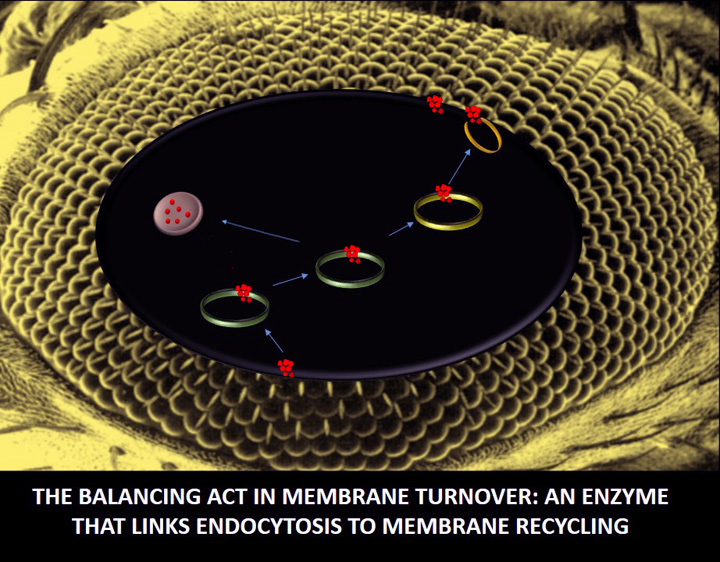The balancing act in membrane turnover: an enzyme that links endocytosis to membrane recycling
Blink. When you wake up, the first thing you do is open your eyes and see.
All cells have surface membranes, and this membrane is especially important in the light-sensitive cells of the eyes in your body. Within your eyes are millions of photoreceptors - nerve cells that capture light to form images of the world around you. The surface membranes of these nerve cells are packed with rhodopsin, a protein that detects light. These are the light-sensing membranes of the eyes that absorb packets of light to trigger nerves causing the sensation of sight.
Once triggered by light, rhodopsin molecules on the surface membrane must be 'reset' in order to sense light again, a process that occurs within the cell. This requires rhodopsin to be moved into the cell and for 'reset' rhodopsin to be recycled back onto the surfaces. Therefore, to function normally, the light-sensing membranes in these cells undergo constant recycling to restore the light-detectors they carry.
Scientists from the National Centre for Biological Sciences (NCBS), Bangalore, and the Babraham Institute in UK have recently found a critical player essential for proper membrane recycling. Using the light-sensitive membranes of fruit-fly eyes as a model system, the researchers have discovered that the enzyme Phospholipase D or PLD is necessary for membrane recycling to sustain normal sight.
The resetting of rhodopsin molecules begins with a process called endocytosis, where the cell pinches off parts of its surface membranes into structures called endosomes. The rhodopsin in these endosomes is eventually recycled back onto the cell surface for further events of light detection. Since a photoreceptor's sensitivity depends on how many rhodopsin molecules it has on its surface, membrane turnover in these cells is critical in preserving normal eyesight.
"You can think of endocytosis and membrane recycling as two arms of the membrane turnover process," says Raghu Padinjat from NCBS. "There needs to be a balance between the two, or else the size of the membrane will shrink - a condition that could lead to retinal degeneration in the eyes. This is actually seen in an inherited genetic disease, a rare disorder called Best's macular degeneration," he adds.
However, the connection between endocytosis and the eventual recycling process to maintain photo-sensitive surface membranes have remained unclear - until now. A collaborative study from Padinjat's laboratory at NCBS and the Babraham Institute in UK, has found that a well-known enzyme called Phospholipase D or PLD plays a central role in linking endocytosis to membrane recycling.
Using fruit fly photoreceptor cells as a model system, the team has found that when these cells are exposed to light, PLD is switched on, and that its activity is essential in coupling endocytosis with recycling of rhodopsin back to the cell surface.
In mutant flies that lack PLD in their photoreceptors, the endocytosis process is unlinked from membrane recycling. When exposed continuously to light, the cell surface of photoreceptors in mutant flies gradually shrinks, with reducing rhodopsin levels that make it progressively less sensitive to light. Without PLD activity, the retina gradually degenerates and mutant flies go blind.
Despite identifying a key player in the membrane turnover process, Padinjat's team believe that many more gaps need filling in understanding the phenomenon. For example, the work shows that the PLD activity in photoreceptors is light-activated, but how this happens is still unresolved.
"The light receptor, rhodopsin is on the membrane surface, and can detect light when the surface of the cell is illuminated. But PLD, which is also light-activated, is somewhere inside the cell. So how is the information about perceived light conveyed to PLD for it to get activated?" asks Thakur. "We also need to fill in blanks about how PA actually affects membrane recycling and the turnover process. Our finding has opened up more questions to answer in the membrane turnover process," he adds.
But the results from this study are not limited only to membrane turnover in the light-sensitive membranes of the eyes. Membrane turnover is a critical mechanism that maintains cell surface area. In cells that have expanded cell surfaces such as those lining the airways of the lungs or the nutrition-absorbing cells of the gut, maintaining cell surface area is essential for their normal function. Even processes such as cell migration have extensive endocytosis and membrane recycling events that must be tightly regulated.
"Therefore, regardless of what the cell type is, there need to be mechanisms to couple endocytosis with recycling of membrane," says Padinjat. "And that is the importance of our work - we define a mechanism by which cell membrane size is regulated," he adds.
The research described in this article has been published as a paper titled "PhospholipaseD activity couples plasma membrane endocytosis with retromer dependent recycling" in the journal eLife in Novmber 2016. The paper can be accessed at https://elifesciences.org/content/5/e18515

Comments
Post new comment